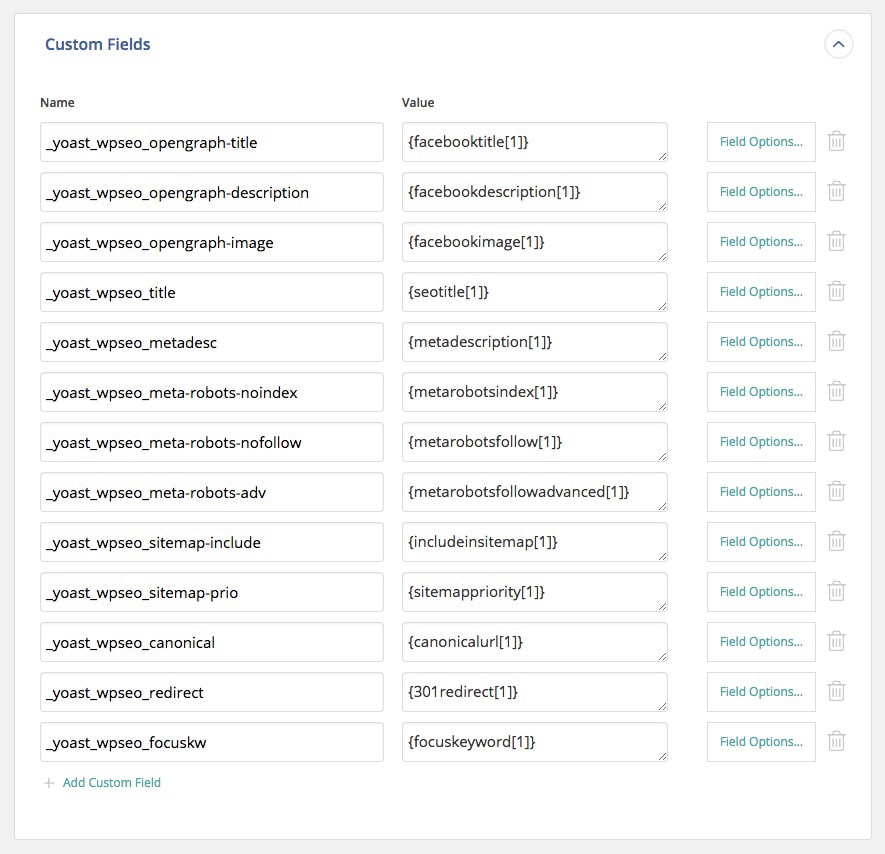Yoast WordPress SEO
In this tutorial, you’ll learn how to import posts into WordPress along with their settings for the Yoast WordPress SEO plugin. WP All Import makes it easy to import data into almost any plugin or theme.
You can complete this import manually, as described below, or you can use the Yoast Add-On for WP All Import: https://wordpress.org/plugins/yoast-seo-settings-xml-csv-import/
The settings for Yoast are stored in custom fields attached to every post. Watch the video tutorial below to see how easy it is to import these settings:
Just like importing other custom fields, you can manually enter the field name into WP All Import, or you can choose to have WP All Import auto-detect all of the custom fields attached to the post type you’re importing to. Remember, for WP All Import to detect these custom fields, there must be at least one post on your site using them.
Yoast uses thirteen different custom fields to store settings for your posts. If you don’t import a value to a custom field, then Yoast WordPress SEO will simply assign your post the default for that field.
| Name | Custom Field | Values |
|---|---|---|
| Focus Keyword | _yoast_wpseo_focuskw | Text string |
| SEO Title | _yoast_wpseo_title | Text string |
| Meta Description | _yoast_wpseo_metadesc | Text string |
| Meta Robots Index | _yoast_wpseo_meta-robots-noindex | Blank for default, 1 for noindex, or 2 for index |
| Meta Robots Follow | _yoast_wpseo_meta-robots-nofollow | Blank for follow, 1 for nofollow |
| Meta Robots Advanced | _yoast_wpseo_meta-robots-adv | Blank for default, none, noodp, noydir, noimageindex, noarchive, or nosnippet |
| Include in Sitemap | _yoast_wpseo_sitemap-include | Blank for auto, always, or never |
| Sitemap Priority | _yoast_wpseo_sitemap-prio | Blank for auto, 1 to .1 |
| Canonical URL | _yoast_wpseo_canonical | Canonical URL of post |
| 301 Redirect | _yoast_wpseo_redirect | URL to redirect post to |
| Facebook Title | _yoast_wpseo_opengraph-title | Text string |
| Facebook Description | _yoast_wpseo_opengraph-description | Text string |
| Facebook Image | _yoast_wpseo_opengraph-image | URL to image |
| Twitter Title | _yoast_wpseo_twitter-title | Text string |
| Twitter Description | _yoast_wpseo_twitter-description | Text string |
Here’s an example of how your import template might look while importing Yoast WordPress SEO settings:

Importing SEO Data for Taxonomies
Yoast stores taxonomy SEO data via the Options API, so the Term Meta section won’t work. Instead, you’ll need to use our add-on for Yoast: https://wordpress.org/plugins/yoast-seo-settings-xml-csv-import/. In the import settings, you’ll still use the term meta section to decide which fields to update. Here are all of the available taxonomy fields:
| Name | Custom Field | Values |
|---|---|---|
| Focus Keyword | wpseo_focuskw | Text string |
| SEO Title | wpseo_title | Text string |
| Meta Description | wpseo_desc | Text string |
| Meta Robots Index | wpseo_noindex | Blank for default, 1 for noindex, or 2 for index |
| Include in Sitemap | wpseo_sitemap_include | Blank for auto, always, or never |
| Canonical URL | wpseo_canonical | Canonical URL of post |
| Facebook Title | wpseo_opengraph-title | Text string |
| Facebook Description | wpseo_opengraph-description | Text string |
| Facebook Image | wpseo_opengraph-image | URL to image |
| Twitter Title | wpseo_twitter-title | Text string |
| Twitter Description | wpseo_twitter-description | Text string |
| Twitter Image | wpseo_twitter-image | URL to image |

Import Any CSV, XML, or Excel to WordPress
- Any theme or plugin
- Images & galleries
- Custom fields
- Categories & tags
- Woo, ACF, Meta Box, JetEngine
Related Docs
This overview explains how to import into Custom Fields using WP All Import.
Learn how to export Custom Fields using WP All Export.
This documentation explains how to bulk edit data using our plugins.